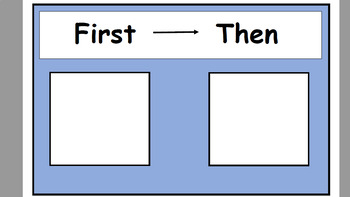Today, I want to talk about a fantastic tool that can greatly benefit children with autism - the First-Then Board. This visual support system has proven to be highly effective in helping children with autism understand and navigate their daily activities.
First-Then Board - Visual Support for Children with Autism
 The First-Then Board is a simple but powerful tool that can be used at home, in school, or in therapy sessions. It consists of two sections: a “First” section and a “Then” section. The purpose of the board is to visually illustrate the sequence of activities or tasks that a child needs to complete.
The First-Then Board is a simple but powerful tool that can be used at home, in school, or in therapy sessions. It consists of two sections: a “First” section and a “Then” section. The purpose of the board is to visually illustrate the sequence of activities or tasks that a child needs to complete.
For children with autism, understanding and following a sequence of activities can be challenging. The First-Then Board provides a clear and structured visual representation of what needs to be done, reducing anxiety and confusion. The child is able to see what activity they need to complete first, and what they will be rewarded with afterwards.
Here’s an example of how the First-Then Board works:
- First: Brush your teeth
- Then: Play with your favorite toy
The First-Then Board can be customized to suit the individual needs and interests of each child. It can be created using a variety of materials such as paper, laminated cardstock, or even digital apps. The key is to make it visually engaging and easy for the child to understand.
How to Use the First-Then Board
Using the First-Then Board is simple and straightforward. Here are some tips to get started:
- Introduce the First-Then Board to the child and explain how it works. You can use simple language and visuals to illustrate the concept.
- Choose activities or tasks that are appropriate for the child’s age and developmental level. It’s important to consider the child’s interests and preferences to make the board more motivating.
- Place the board in a visible location where the child can easily see it. This could be on a wall, a desk, or even a portable board that can be carried around.
- As the child completes each activity, they can move a marker or a picture to the “Done” section of the board. This provides a sense of accomplishment and progress.
- Make the “Then” section of the board attractive and exciting for the child. It can include images of their favorite toys, activities, or rewards. This acts as a visual reminder of what is waiting for them once they complete the first task.
- Provide verbal praise and positive reinforcement when the child successfully completes each activity. This will help reinforce the connection between the First-Then Board and the desired behavior.
Benefits of the First-Then Board
The First-Then Board offers numerous benefits for children with autism:
- Promotes independence: By providing a clear visual structure, the board empowers children to complete tasks on their own.
- Reduces anxiety and frustration: The First-Then Board eliminates ambiguity and uncertainty, which are common triggers for anxiety in children with autism.
- Improves focus and attention: The board helps children stay on task by breaking down activities into smaller, manageable steps.
- Enhances communication skills: The visual nature of the board aids in comprehension and supports language development.
- Encourages positive behavior: The First-Then Board serves as a positive reinforcement tool, motivating children to complete tasks and follow routines.
As you can see, the First-Then Board is a valuable resource that can make a significant difference in the lives of children with autism. It promotes independence, reduces anxiety, improves focus, enhances communication, and encourages positive behavior. If you have a child with autism or work with children on the spectrum, I highly recommend incorporating the First-Then Board into their daily routines.
Remember, every child with autism is unique, so it’s important to tailor the First-Then Board to their individual needs and interests. Experiment with different visuals, formats, and activities to find what works best for them. With patience, consistency, and the right tools, you can help children with autism thrive and reach their full potential.